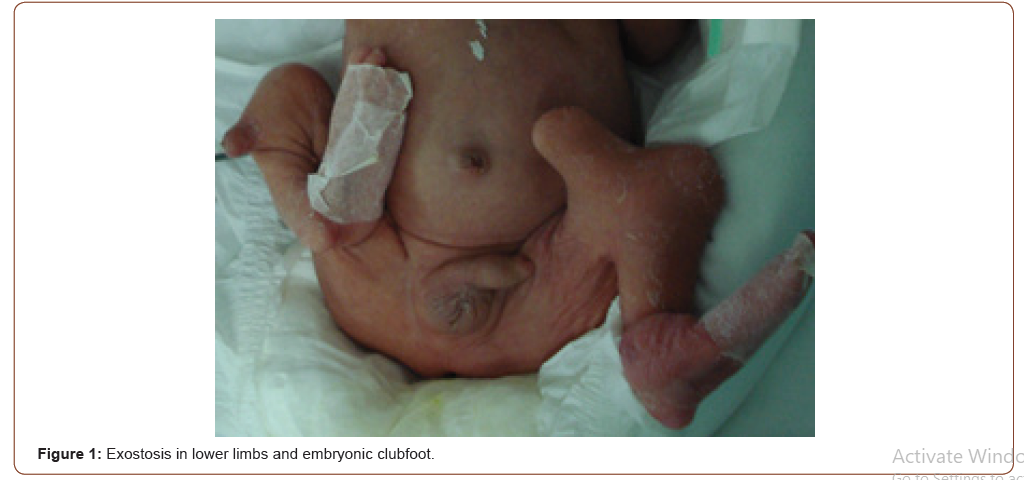 Case Report
Case Report
Multiple Exostosis and Embryonic Clubfoot in a Premature Newborn: Case Report
Fernanda Martins Coelho Catharino1, Marco Orsini2*, Jacqueline Stephanie Fernandes do Nascimento3, Antonio Marcos da Silva Catharino4 and Marco Azizi5
1Post-Graduated in Pediatrics PUC-RJ, Brazil
2Iguaçu University (UNIG), Severino Sombra University (USS), Brazil
3Iguaçu University (UNIG) - Faculty of Medicine, Brazil
4Master in Neurology-UNIRIO; Titular Member of the Brazilian Academy of Neurology; Associated Professor of Neurology – UNIG; Physician at the Neurology Service of the General Hospital of Nova Iguaçu, Brazil
5Unig University, Brazil
Antonio Marcos da Silva Catharino - Rua Gavião Peixoto 70, Sala 811 - Icaraí - Niterói - Rio de Janeiro – Brasil - CEP: 24230-100, Brazil.
Received Date: July 23, 2020; Published Date: August 24, 2020
Introduction
Multiple exostosis is an inherited, autosomal dominant condition, characterized by multiple cartilaginous lesions, developed from the metaphysis of long bones, mainly in the proximal and distal regions of the femur [1].
Case Report


Premature, male newborn, 27 weeks of gestational age, birth weight 1215 kg, Apgar score in the first, fifth and tenth minutes was, respectively, 2/6/8, vaginal delivery, blood group A. He had structural abnormalities in lower limbs compatible with multiple exostosis and embryonic clubfoot (Figure 1), evidenced by simple radiography (Figure 2). Mother without prenatal care, with membranes’ rupture for over a month, Gestation I / Delivery 0, HIV / VDRL / Coombs direct negative, blood group A [2].
Discussion
The exostosis can be asymptomatic or associated with complications caused by compression of adjacent structures [3]. The diagnosis is made in the first life decade, based on clinical evaluation and radiological exams, changes are rarely present at birth [1,2].
Conclusion
Multiple exostosis is not classified as a true neoplasm, however, it is configured by the appearance, in childhood and adolescence, of bony protuberances surrounded by hyaline cartilage. The primary involvement occurs in the tubular bones, iliac wing and scapula, however, the entire skeleton can be compromised. It is known that less than 5% of cases evolve to the malignant form: chondrosarcoma. Congenital clubfoot, in turn, is characterized by generalized deformations of the musculoskeletal tissues distal to the knee. Until the current date, there are no reports of a causal relationship for both injuries, and further studies on this relationship are necessary.
Acknowledgement
None.
Conflict of Interest
No conflict of interest.
References
- Legeai-Malett, L (2002) Hereditary Multiple Exostosis. Disponível em: www.orpha.net/data/patho/GB/uk-HME.pdf.
- Canet AR, Cuixart VB, Silveria LL (2006) Exostosis múltiple. An Pediatr (Barc) 65(5): 500-510.
- Lemos MC, Peter Kotanko, Paul T Christie, Brian Harding, Theodora Javor, et al. (2005) A Novel EXT1 Splice Site Mutation in a Kindred with. J Clin Endocrinol Metab 90(9): 5386-5392.
-
Fernanda Martins Coelho Catharino, Marco Orsini. Multiple Exostosis and Embryonic Clubfoot in a Premature Newborn: Case Report. 8(3): 2020. ANN.MS.ID.000689.
-
Neurostimulation, Brain, Electrotherapy, Radical predictive processing, Brain oscillations, Global brain states, Epilepsy, Neural dysfunction, Parkinson’s disease.
-

This work is licensed under a Creative Commons Attribution-NonCommercial 4.0 International License.






